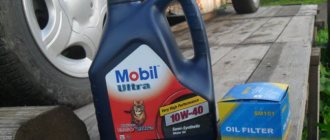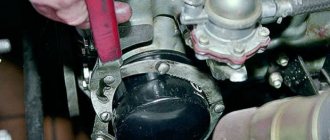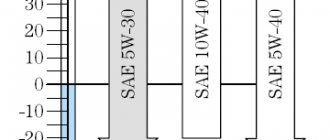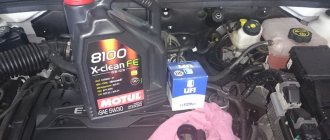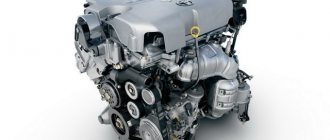Technical specifications 4B11 2.0 l165 l. With.
To ensure performance characteristics, the designers of the GEMA alliance used an in-line engine design with 4 cylinders. Not only the cylinder head and the intake manifold, but also the cylinder block are made of aluminum alloy in the engine.
Cylinder block 4B11
For the basic atmospheric version, the technical characteristics of 4B11 have the following values:
| Manufacturer | GEMA Alliance (Chrysler, Mitsubishi, Hyundai) |
| Engine brand | 4B11 (G4KD) |
| Years of production | 2005 – … |
| Volume | 1998 cm3 (2.0 l) |
| Power | 110 – 121.4 kW (150 – 165 hp) |
| Torque moment | 196 Nm (at 4800 rpm) |
| Weight | 241 kg |
| Compression ratio | 10,5 |
| Nutrition | injector |
| Motor type | in-line petrol |
| Ignition | DIS-4 |
| Number of cylinders | 4 |
| Location of the first cylinder | TVE |
| Number of valves on each cylinder | 4 |
| Cylinder head material | aluminum alloy |
| Intake manifold | duralumin |
| An exhaust manifold | cast iron |
| Camshaft | 5 supports, 8 cams |
| Cylinder block material | aluminum alloy |
| Cylinder diameter | 86 mm |
| Pistons | cast aluminum |
| Crankshaft | 5 supports, 8 counterweights |
| Piston stroke | 86 mm |
| Fuel | AI-95 |
| Environmental standards | Euro 4 |
| Fuel consumption | highway – 5.6 l/100 km combined cycle 7 l/100 km city – 9.3 l/100 km |
| Oil consumption | maximum 1 l/1000 km |
| What kind of oil to pour into the engine by viscosity | 5W30, 5W20 |
| Which engine oil is best by manufacturer | Liqui Moly, LukOil, Rosneft, Motul, Mannol, Mobil, Castrol |
| Oil for 4B11 by composition | synthetics, semi-synthetics |
| Engine oil volume | 4.1 l in engines until 2012 |
| Operating temperature | 95° |
| ICE resource | declared 250,000 km actual 350,000 km |
| Adjustment of valves | washers |
| Cooling system | forced, antifreeze |
| Coolant volume | 7.5 l |
| water pump | 1300A083 |
| Spark plugs for 4B11 | DIFR6C11 from NGK or FR5EI, 14mm thread, 19mm long, 16mm key |
| Spark plug gap | 1.1 mm |
| Valve train chain | four-row, 1140A073 Mitsubishi |
| Cylinder operating order | 1-3-4-2 |
| Air filter | LYNXauto LA1958 |
| Oil filter | Champion COF102126S, Bosch 0986B00015 |
| Flywheel | 7 mounting holes, lightweight type |
| Flywheel mounting bolts | M12x1.25 mm, length 26 mm |
| Valve stem seals | NOK MN183952 |
| Compression | from 13 bar, difference in adjacent cylinders maximum 1 bar |
| XX speed | 750 – 800 min-1 |
| Tightening force of threaded connections | spark plug – 25 Nm flywheel – 62 Nm clutch bolt – 30 Nm bearing cap – 26 Nm + 45° (main) and 5 Nm + 30 Nm + 90° (rod) cylinder head – 4 stages 3 Nm, 35 Nm + 90° + 90° |
Reviews from car owners
The Mitsubishi ACX crossover captivates with its simplicity. There are also complex design solutions in the car, but, in general, the model does not represent a puzzle or a complex invention. All three engines are reliable, each is good in its own way. Only the variator deserves minor criticism: frequent overheating forces the driver to stop in the middle of the road and wait for it to cool down.
However, there is no need to stop seriously and for long. There is an opinion that this phenomenon is typical only for crossovers with a 1.8 and 2.0-liter engine paired with a CVT. But when equipped with a less powerful 1.6-liter engine, overheating of the variator practically does not occur. What is the service life of a Mitsubishi ACX engine in practice? Reviews from vehicle owners will tell you about this.
Engine 1.6
- Stanislav, Perm. Hi all! Mitsubishi ACX was my first car. I purchased the first generation model in 2010. The modification with the 4A92 engine completely suits me. I am satisfied with the dynamism and cross-country ability of the car. I use it mainly in the city, rarely go on the highway, and have not gone on long trips, although I have such plans. I note that at the moment the mileage is 180 thousand km, and the engine still works like new. I didn’t notice the “maslozhor”; I poured oil from change to change. I prefer to use Castrol 5W40. During the entire period of operation, I replaced only the timing drive, which served exactly 100 thousand km.
- Yuri, Moscow. When owning a Japanese vehicle, it is important to understand that warranty and real life are different concepts. The warranty period of Mitsubishi ACX is 150 thousand km. This means that during this period of operation of the car, serious damage to the engine will not occur, if, of course, the driver follows at least the basic rules of car maintenance. The actual service life of the 4A92 engine varies from 250 to 300 thousand km. I have a first generation Mitsubishi ASX from 2012. I took the crossover new from the showroom. The car is in excellent condition, although there are already 120,000 km on the odometer. The timing drive is original.
- Nikolay, Irkutsk. Previously, engines were more reliable than they are now - that’s a fact. The increased wear of CPG parts in modern installations is due to their greater potential in terms of power. But no one forces you to rev the engine to the fullest. With a moderate driving style, you can keep your crossover engine in excellent condition for years. I drive slowly, rarely rev the engine, only when overtaking on the highway. The car gives me the warmest feelings, despite the fact that many Mitsubishi owners complain about the “burning” of engine oil. The car's mileage is 180 thousand km - the flight is normal, I don't add oil.
- Nikita, Vladivostok. I liked the design of the Mitsubishi ASX, after which I spent a long time studying the technical characteristics of the crossover. Ultimately, I took a risk and purchased a modification with a 1.6-liter engine. I have come across information on the Internet more than once that this engine “eats” oil. I was convinced of this for myself. Even though I have already driven the car for more than 250,000 kilometers, the compression in the cylinders is from 12.7 to 13.3, but the oil “eats” like a KAMAZ. On average I add 600-700 ml for every thousand kilometers.
- Maxim, Tula. When conversations turn to engine life, I immediately remember Russian roulette - whether you'll be lucky or unlucky. Of course, a lot depends on the quality of service. But identical installations with identical quality maintenance can cover different kilometers. What is this connected with? I just can't understand it. I have a Mitsubishi ASX with a mileage of 250,000 km and the oil scraper, piston rings and caps have already been replaced. And a colleague has the same modification of a crossover with a mileage of 318,000 kilometers and whatever.
The 1.6-liter engine requires careful handling. The installation does not like overheating. Mitsubishi ASX is a good option for quiet everyday trips around the city. But for lovers of drive, it’s best to take a closer look at other modifications of the crossover. The resource 4A92 is designed for 250-280 thousand kilometers.
Motor 1.8
- Mark, Sochi. I have a sad experience of owning a Mitsubishi ACX. I purchased the car in 2013 with a 1.8-liter engine. After traveling 150,000 kilometers, the engine began to “eat” oil: up to 1 liter of lubricant was needed per 1,000 kilometers. I measured the compression and it dropped. The car began to have trouble starting. I went to the service station and they said that there were scuffs on the pistons and cylinders. As a result, the cylinders had to be lined; the repairs were expensive. At the same time, I changed the timing chain. I still don’t understand what caused the breakdown. For now I continue to drive.
- Kirill, Taganrog. I have always had a special love for Japanese cars. I had both a Lancer and an Outlander with engines 4A92, 4B10, 4B11. Based on the experience of operating these cars, I can say that 4B10, 4B11 last more than 300 thousand kilometers, but 4A92 seemed problematic to me. After 120 thousand km, it was necessary to replace the oil scraper rings and caps. I think the most reliable is 4B10. This engine has a long service life and an adequate level of fuel consumption.
- Semyon, Rostov. Before ACX, I drove a ninth-generation Lancer. The engines are identical here and there. Ninth Lancers are still used by taxi drivers. The picture is approximately as follows: 300-350 thousand pass, after replacing rings, caps, gaskets, and then how long will pass. Often the resource completely exhausts itself after 600 thousand kilometers. But even this indicator can be considered excellent. Now it turns out that the sooner the better. The optimal frequency is every 7,000 kilometers. This way the engine will last longer.
- Valentin, Cheboksary. The actual service life of a Mitsubishi ACX engine depends on multiple indicators. This includes both the quality of service and the quality of fuel supplied. It is necessary to take total care of everything so that the engine lasts for a long time and without problems. I have owned a crossover since 2010, the first generation model with a 1.8 liter engine. According to the odometer, 240 thousand km is the real untwisted mileage. I don’t add oil, only original consumables. I am sure that 380-400 thousand km is the real resource of 4B10.
- Ilya, Murmansk. A year ago I sold an ACX with a mileage of 210 thousand km. The 4B10 engine is working, normal, I did not add oil. Therefore, I can responsibly declare that the resource of the power unit is exactly 200,000 kilometers. And then, as the service book says, monitor the condition of the engine and take the necessary measures in a timely manner.
Article on the topic: How to charge a maintenance-free car battery?
The second most reliable power unit in the range of Mitsubishi ACX engines. The older “brother” of the problematic 1.6-liter engine got rid of many design flaws inherent in previous Japanese engines. The only difficulties that a car can cause to the owner are related to the suspension - shock absorbers, stabilizers, rods. The 4B10 engine easily travels over 300,000 kilometers.
Engine 2.0
- Vyacheslav, Moscow. The two-liter 4B11 is made of aluminum alloy with open cooling channels, which personally gives me conflicting feelings. Old cast iron engines, in my opinion, are still more reliable and durable. In addition, they are more resistant to overheating. Yes, the 4B11 is equipped with a timing chain drive, which inspires more confidence among drivers than a timing belt. Such an engine requires less maintenance and therefore costs less money. I drive a 2011 ACX, the first generation model. The mileage to date has exceeded 150,000 kilometers. I haven't changed the chain yet!! This is an undeniable advantage of a modern engine. But you never know how much time the drive has left; the tensioner often fails, although the chain itself is still usable. In general, the actual resource of the engine is 400,000 kilometers and this is the minimum.
- Igor, St. Petersburg. The Mitsubishi ASX crossover is durable, practical and comfortable. I recommend purchasing the second generation of the model with the bugs corrected. Choose a modification with a two-liter engine. The 4B11 motor is resource-intensive and reliable. Its only drawback is its noisy operation. Sometimes it seems that an old diesel engine is installed under the hood of a foreign car. But as the temperature reaches the operating range, the noise decreases. If you believe the odometer, then in 6 years I have covered 176,000 kilometers. Replaced a knocking timing chain. I didn't get into the engine again. Oil change every 6,000 kilometers. I only use the substance recommended by the manufacturer. With quality service it will last 500,000 km.
- Vasily, Tyumen. Hello! I am the owner of a 2020 Mitsubishi ASX crossover. Under the hood of my car there is a naturally-aspirated two-liter 4B11 power unit. After completing the break-in period, the first maintenance was carried out: replacing the engine oil, air and fuel filters, and spark plugs. This was the only MOT that I went through with the officials. Then I serviced the car myself. There is nothing complicated here: change the oil every 6-7 thousand km, filters and other consumables. It is recommended to install only original components. This is the only way to extend the life of the engine. Well, and, of course, refueling with high-quality high-octane fuel. Mileage 75,000 kilometers - no problems.
- Anatoly, Kursk. Mileage 170 thousand km, vehicle manufactured in 2013. Six months ago, he flew into a ditch, so much so that they only pulled him out with a tractor. After a while I noticed that the pump had fallen out of my head; I did not immediately change the belt. The timing drive was replaced only now, when the engine began to “eat” oil, and fuel consumption increased by 20 percent. There were no more problems.
- Denis, Voronezh. Good day! Recently I thought about the service life of the Mitsubishi ACX 2.0 engine. I traveled to warm regions in the summer, and along the way I used about a liter of IDEMITSU 5W30 ISU oil. Upon returning home, I decided to switch back to my native lubricant, but I did not feel any improvement. I went to a service station, where a competent specialist told me that the service life of the 4B11 engine is more than 500 thousand km, but in our operating conditions it is 350-400 thousand km at best. As for my engine, I’ll have to do a major overhaul now (around 180 thousand rubles). I can’t say that I was unlucky, because the mileage of the car is 368 thousand!
When purchasing a new or used Japanese crossover, it is important to understand that the power plant can only fully exhaust its service life with high-quality and conscientious service. 4B11 ranks first in the ranking of the most reliable Mitsubishi ACX engines. A crossover with this engine covers an average of 400,000 kilometers, as evidenced by owner reviews.
Share with friends on social networks:
Telegram
Tuning the 4B11T engine
Stage 2
Mitsubishi 4G15 1.5 l engine
It is very easy to increase power on your Evo X, just install a cold intake, remove the catalyst, replace the connecting rod bolts with ARP or install normal H-shaped connecting rods, buy a boost controller and configure the control unit. This will give 370+ hp. You can leave the stock connecting rods, but their breakage will be a matter of time. Add a pump like the DW65C, 1000cc injectors, blow-off, oil churner, 76mm exhaust and tune up. You'll get about 400 horses at the flywheel. This is the optimal combination of speed and reliability, which is how most Evolution 10s drive. A Garrett GTX3071R with a good tuning manifold, a large intercooler, 3.5-inch pipes, and a pump like the AEM 320 lph will help you get more power. Also needed are Cosworth MX1 shafts and valve springs, 1300cc injectors, AEM fuel rail, ARP studs. After tuning, such a motor will easily show 400+ hp. on wheels. You can install a GTX3076R and get 500+ horsepower on wheels. Stock pistons and block hold this power and even more, but for reliability it is better to switch to forging, properly prepare the cylinder head, and do it as it should.
Ralliart Stage 2
You can add power to the Lancer Ralliart X engine by replacing the filter with K&N, removing the catalyst, or installing a catless exhaust on a 76 mm pipe and flashing the brain. This will give about 300 hp. and dynamics at the level of the stock Evolution X. If this is not enough, then you need to remake it for this very Evo, replacing the intake with the same one from the Evo X along with an intercooler, with pipes, with an oil cooler, with a TD05H turbine and with a manifold. The intake is noticeably different and you will have to completely redo it or immediately install a tuning cold intake. The release also requires modification or, again, installing a rollless one with a diameter of 76 mm. After the conversion, you can follow the path of tuning the Evo 4B11T: cold intake, 76 mm exhaust, ARP connecting rod bolts, boost controller and firmware. With all this, your Ralliart will drive like most Eviks with a chip exhaust.
ENGINE RATING: 5-
Motor
The power unit with the factory marking 4B10 was installed on crossovers supplied to Russia from 2010 to 2020. Why the manufacturer subsequently abandoned this vehicle configuration option is not entirely clear. Like all engines in the Theta II family, this engine is quite reliable. Its traction characteristics are also not satisfactory. For a relatively small displacement, the power is 140 hp. With. and a torque of 177 Nm are quite decent indicators, allowing the Mitsubishi ACX 1.8 to accelerate to 189 km/h, crossing the 100 km/h mark 12.7 seconds after the start.
Engine 4B10 for Mitsubishi ACX 1.8 crossover
There are no critical flaws in the design of the 4B10 engine, and the list of known problems only includes:
- excessive noise, which increases as the timing chain is pulled out;
- vibrations resulting from failure of electrical and electronic components.
However, those who buy 1.8 should remember that the manufacturer does not provide the possibility of a major overhaul for the 4B10. Pistons and rings of repair sizes are not included in the spare parts catalogues. Before purchasing a crossover, it is necessary to carry out a complete diagnosis of the motor. If the resource of the power unit installed on the crossover exceeds 200 thousand km, then it is hardly advisable to buy such a car.
Those who are interested in what kind of oil to fill in the Mitsubishi ACX 1.8 should take note that lubricants with parameters that meet the requirements of API/ACEA SM/A3, A5 standards, with a viscosity of SAE 0W-20, 0W are best suited for a car engine. -30, 5W-40 5W-30. These lubricants can be used over the entire operating temperature range. As for the specific manufacturer, car owners are free to choose for themselves. Of course, these must be motor oils of proven brands.
Maintenance schedule 4G1592 180 l. With.
Engine Nissan YD25DDTi
The in-line naturally aspirated Japanese 4G15 engine requires maintenance within the following periods:
- due to the unequal design of the timing belt and the BC head, the oil is changed after 5 - 10 thousand mileage, a new oil filter is installed;
- clogging of the fuel filter occurs after 4 years, the air filter cartridge after 20 thousand km;
- the exhaust manifold of naturally aspirated engines begins to burn out at the turn of 20,000 km, of turbocharged modifications earlier;
- the coolant requires replacement after 40 thousand km, as it begins to lose its properties;
- attachment belts should be changed after 50,000 km, timing belt after 90 thousand mileage;
- crankcase ventilation is purged after 30,000 km;
- spark plugs are changed at 20,000 km, battery after 50,000 km;
- in engines without hydraulic pushers, the thermal valve clearances are adjusted after traveling 30,000 km.
Replacing the timing belt
In general, the design of the internal combustion engine is quite simple; the engines are conventionally classified as “million-dollar”.
see also
Comments 116
It's strange to read this. I drive a ’13 Lancer with 4A92 engine. I took 90 thousand mileage from the dealership. And even now I don’t have to add oil. The level is maintained from replacement to replacement. We conclude that changing the oil after 15 thousand km, as recommended by the dealer, is killing the engine. Personally, I change every 7-8.
Same story, same 1.6 4A92 engine, the car is also 2013! Only the mileage is 175,000 km, I started taking oil at 130,000 km (I only use the original 0W30 from the passenger compartment - I am the only owner), the piston skirt began to clank at 150,000 km, there was no time to get into the engine, I needed wheels - I hoped that everything would be the same The end of valve stem seals has come! After opening at 172,000 km. The engine in terms of deposits and deposits is ideal (there are simply none!), the camshaft and crankshaft (as well as the liners) are ideal. In all four cylinders there are compression valves 1 and 2, oil scraper valves, oddly enough, no! The piston burned out, only the first cylinder and a drop on the cylinder of 2x1 cm! There are bullies on 1, 3 and 4! cylinders in plus 0.04, first 0.05. The pistons are almost normal (except for the first one!). The rings are in perfect condition (no wear!)! M. caps are soft - no cracks! What did you do?! Now the wheels are needed, at least until summer! It was decided to make temporary repairs before the summer! Buy a used piston, remove the rings, clean the grooves, put the rings in place. Level the burnt drop using heat-resistant cold welding Abro TM185. The engine was disassembled and reassembled in 4 days (I repair it myself, without a garage!). Now the mileage is + 3000 km. — it doesn’t take oil! We bought a used piston with a connecting rod - 2200 rubles, smoothing the cylinder head Pullman NM913507 - 1012 rubles, gasket former Permatex 89148 - 400 rubles, crankshaft oil seal Mitsubishi MN195668 - 300 rubles, Abro TM185 - 330 rubles, valve cover gasket SAT K1035A991 — 130 rubles, exhaust pipe gasket Mitsubishi MR450706 — 520 rubles; cylinder head bolt and intake manifold ring - left the old ones! Total: 4892 rubles, repairs - 0 rubles. Plans for the summer: to sleeve the block! I have already selected blanks for the sleeves (approximate size) 4 x 660 RUR. = 2640 rubles, agreed with a turner to adjust the size of the sleeves 3000 rubles, found a place for the sleeve of the block (at an adequate price) 6000 rubles. + grind the block and head 1500 rub., Teikin pistons 43296050 4 x 1110 rub. = 4440 rub. Total: 17580 rub. And now the conclusion! If you pour the correct oil and do not pull, i.e., as soon as the engine begins to eat up oil, immediately disassemble and clean the ring grooves, then the engine will run for a very long time and even longer! A burnt-out piston and scuffing on the cylinders are a consequence of the rings being stuck and the fact that the above was not done in time! It's not about the engine - it's about how they look after it! In the future, we will live not die, I will not repeat my mistake! PS The oil started to eat up (now it’s clear that the rings were stuck!) after a trip to Crimea - apparently the engine warmed up on the serpentine road (even though it wasn’t boiling)!
Hello. What condition was the chain in when opened, with a mileage of 172 thousand km?
And also, you bought a used car, as I understand it, this means the operating history is unknown, even friends won’t tell the whole truth, well, that’s how the world works, so talking about the quality of the Mitsu brand, after the problem that arose after buying a used one. car, I would say incorrectly, the problem was with engines 4a91, 1.5, it’s just a bad dream and some kind of terrible story about this engine, then they installed 4a92 and there were no problems, it all depends on the operation and care of the car.
Maintenance schedule 4B11 2.0 l165 l. With.
Engine Toyota 2NZ-FE
The 4B11 naturally aspirated in-line engine should be serviced in a garage or service station within the following periods:
- The timing chain runs about 150,000 km;
- it is recommended to adjust valve clearances after 30,000 miles;
- The manufacturer provides for cleaning the crankcase ventilation once every 2 years;
- the manufacturer recommends using new engine oil and filter after 7500 km;
- the fuel filter can last 40,000 miles;
- According to the manufacturer's regulations, the air filter must be replaced annually;
- From the factory, antifreeze additives lose their properties after 40,000 km;
- engine spark plug life is about 20,000 mileage;
- already after 60,000 km, the walls in the intake manifold begin to gradually burn out.
Maintenance 4B11
We are replacing
The process of replacing lubricant in the engine is not too complicated, so any car enthusiast can handle it.
What will you need?
Before carrying out technical work, prepare in advance everything that you may need in the process:
- new Engine Oil in a five-liter package;
- new engine oil filter;
- containers for collecting spent MM;
- WD-40 liquid;
- slotted screwdriver;
- O-ring for drain hole.
A special container for draining used MM - you can make a homemade slotted screwdriver - you may need to clean the threads of the drain hole from the remnants of the old sealing ring.
Having prepared all this, you can begin the actual process of changing the engine oil.
Step-by-step instruction
First, you need to find a hole or a lift - this makes changing the MM much more convenient.
- Having arrived at the pit, take a wrench and WD-40 fluid and crawl under the bottom of the car. You need to dismantle the Mitsubishi ACX engine protection. To do this, lubricate the mounting bolts with WD-40 and wait a few minutes so that they can loosen. As a rule, the bolts become sour and in this case they must be removed very carefully, since there is a possibility of damage. So, unscrew the four screws securing the engine protection of your Mitsubishi ACX.
- After removing the protection, you will see the MM drain plug.
- Next, take a container to collect used lubricant and place it under the plug. Note! The drain plug should be unscrewed when the engine has cooled down a little. It is highly not recommended to change the engine fluid on a hot engine, since you can get burned by hot oil, so give the unit some time to cool down.
- Use a wrench to unscrew the drain cap. The process of draining the used consumables has begun. Wait about 30-40 minutes until the MM is completely merged.
- If you are changing the MM by flushing the engine, then tighten the drain cap. Next, pour about four liters of flushing fluid into the engine and start the engine. Let it work for a while, or better yet, get behind the wheel and take it for a ride. It is necessary to drive at least 10 kilometers on the flushing material so that the liquid passes through the entire system and collects all deposits and dirt. After this, you need to drive into the pit and repeat the “flushing” draining procedure.
- Now you need to remove the oil filter. It is located under the bottom next to the drain plug, so it will be more convenient to remove it from under the bottom. Wrap a rag around it to make this easier, as there may be some problems dismantling it. If you are unable to remove the filter element, then use a special key - it is a chain that is wound around the filter for greater ease of dismantling.
- Now go under the car again and replace the O-ring for the drain hole. The old one may fall off, so take a screwdriver and remove all the remains of the old ring.
- Then you need to screw on the drain cap.
- Install a new oil filter in place of the old one, after pouring a little lubricant into it. Also, do not forget to lubricate the rubber elements on the filter itself, if any.
- Open the MM filler neck into the engine and pour about four liters of the substance into it. Remember that when replacing the MM in a Mitsubishi ACX, 4.2 liters should enter the system, but if all the waste liquid is not glass, then, accordingly, less will need to be filled. In any case, use the dipstick to monitor the fluid level.
- Start the engine and let it idle for a few minutes.
- Stop the engine and check the oil level using the dipstick. If everything is in order, tighten the filler cap.
- Reach under the bottom of the car and visually inspect it for leaks. If everything is normal, then screw the engine protection back into place.
Most car owners who purchase a Mitsubishi ACX 1 8 crossover consider this model as a compromise between a rather expensive version with a 2.0 engine and a frankly budget 1.6 package. In Russia, cars in this version are now purchased only on the secondary market. For obvious reasons, potential buyers are concerned about how a used car will behave in the future. Those who have already acquired it want to learn more about how to properly operate such an ASX so as not to encounter serious problems.
The first thing that the vast majority of car enthusiasts pay attention to is the appearance of the car. Only if the appearance of the car does not evoke negative emotions do people begin to study the technical characteristics and delve into the intricacies of the design. Mitsubishi ACX 1.8 looks quite decent. The stylistic solutions used by the designers make it recognizable everywhere. The assets of this model include:
- successful organization of the interior space of the cabin;
- comfortable front row seats;
- well-readable instrument cluster;
- careful adjustment of upholstery panels.
- short front and rear overhangs.
And yet, for a number of reasons, the body design of the Mitsubishi ACX 1.8 crossover raises quite serious criticism. Judge for yourself.
- Despite the fact that the crossover looks like a strong vehicle, problems with the sliding windows - misalignment in the guides and jammed seals - clearly signal that the supporting frame of the body lacks rigidity. The older the car, the higher the likelihood that you will have to deal with squeaks and crickets, change door locks and hinge axles.
- Studying reviews from car owners on websites dedicated to the Mitsubishi ACX 1 8, it is easy to see that the weak point in the crossover body is the trapezoid of the windshield wiper mechanism. You should not try to turn on the wipers if an ice crust has formed on the windshield of your car. This will most likely lead to breakdown.
- Faded and swollen plastic of the crossover instrument panel is considered a common phenomenon. To avoid this, it is necessary to diligently protect the Mitsubishi ACX torpedo from sunlight and regularly treat it with polishing compounds. But if the destructive process has begun, then polishes will no longer help.
- Mitsubishi ASX of early years of production cannot boast of good sound insulation. Extraneous sounds penetrating into the interior of the car really get on your nerves. During the production process, the developers tried to eliminate the problem by installing additional noise-absorbing panels on the crossover. And if, say, on the 2011 Mitsubishi ACX 1.8, some elements of sound insulation were missing, they could well have been borrowed from models released a few years later.
- The crossover is also criticized for its small trunk volume of 384 liters. Despite the fact that by transforming the rear row of seats, the luggage compartment space can be expanded to 1219 liters, this is still not enough for the car to become a good household assistant.
If we add to this the not very impressive performance of the heating and ventilation system, it turns out that there is nothing to praise for. There are clearly more cons than pros.
Motor maintenance schedule
For the 4a92 engine, it is extremely important which oil the car owner chooses to pour. The best choice, recommended by the manufacturer, is to use branded Mitsubishi oil 0W30, 5W30, 5W40, 10W30
The maximum replacement interval is 15,000 km. In the case of dynamic driving, the replacement frequency should be doubled.
Many car owners do not recommend oil from the manufacturer. This is due to the fact that the 4a92 engine has twice the lifespan of third-party branded lubricants. The use of Mitsubishi oil leads to the fact that overhauls have to be carried out when the odometer shows 80-90 thousand kilometers.
Valve adjustment is only necessary on engines without hydraulic compensators. Engine compression and fuel consumption depend on the correctness of this operation. When performing maintenance, you should take into account that the 4a92 engine uses a DOHC circuit, which introduces its own characteristics into valve adjustment.
Ignition and attachments rarely require outside intervention. The main thing is to change spark plugs with 4a92 on time, since the engine is sensitive to the quality of the spark. The manual prescribes replacement every 20 thousand km, without waiting for the spark plug parameters to deteriorate.
Engine 4a92 with attachments
Mitsubishi ASX powertrain range
The model was officially delivered to Russia with three engine options. Initially, cars supplied to the domestic market were assembled in Illinois. Now the crossover is being assembled in the city of Okazaki, in Japan. The model gained popularity among drivers in part due to its family ties to the Outlander. Mitsubishi ACX received the “trolley” of an SUV, but due to the fact that the ASX is much lighter than the Outlander, problems with the suspension occur much less frequently.
Thus, the following modifications of the model are available to domestic buyers:
- 1.6-liter 4A92 engine with a power of 117 horsepower;
- 1.8-liter 4V10 engine with a stated power of 140 horsepower;
- 2.0-liter 4B11 engine with a peak power of 150 horsepower.
There are also versions of the model with diesel engines, but such versions of the car were not officially supplied to Russia. The 1.6-liter engine is coupled to a manual gearbox, while the 1.8-liter equivalent is only paired with a CVT. These units are equipped with the front-wheel drive version of the crossover. The two-liter engine can be used with either a CVT or a manual transmission, and is installed under the hood of the all-wheel drive version of the Mitsubishi ASX.
Resource of 1.6-liter engine
The line of Mitsubishi ASX engines will seem familiar to many fans of Japanese cars. The thing is that the crossover received almost the same power units that the manufacturer previously equipped the Outlander and Lancer with. All engines available for purchase are generally quite good; perhaps the biggest complaint from drivers is the 1.6-liter power unit labeled 4A92. This is an old generation motor that undergoes periodic modernization. Detonations are often observed on cars manufactured before 2012. But now this problem has been completely solved by flashing it, at least that’s what the manufacturer says. But car owners claim the opposite: even on the second generation Mitsubishi ASX with a 1.6 engine, detonations sometimes occur.
The 4A92 engine boasts the longest drive belt for attachments. Changing it yourself is not an easy task. This is probably the only difficulty that causes headaches for car owners when servicing a vehicle. Changing air and fuel filters couldn't be easier. The procedure is similar to how consumables are changed on a domestic VAZ-2110. In general, the 4A92 is not the most capricious engine of all known Japanese installations. Its resource varies from 250 to 280 thousand kilometers. Early breakdowns are due to the fact that an “oil guzzler” was noticed behind the 4A92, and ignoring this fact can lead to the most serious consequences.
Service life of a 1.8-liter engine
The naturally aspirated 1.8-liter engine produces a solid 140 horsepower, allowing the crossover to feel confident on both city and country roads. Due to its reliability and design simplicity, the 4B10 has become almost universally used. The engine is equipped not only with Japanese, but also with American and South Korean cars. Chrysler and KIA, in particular, complete many of their developments with this engine. Structurally, it is an in-line “four” with a 16-valve cylinder head. Each cylinder has 4 valves. The gas distribution mechanism is driven by a long-lasting chain. The 4B10 engine is characterized by the presence of a proprietary MIVEC variable valve timing system.
Fuel injection occurs through electronic injectors. The cylinder head is made of aluminum alloy. If on previous power units from Mitsubishi there was only one phase shifter on the intake shaft, then in the 4B10 there are already two such devices - on the intake and exhaust shafts. The engine is sensitive to changes in operating temperature, and this is important to consider when operating the Mitsubishi ASX. If it happens that the engine overheats, there is no need to try to cool it by radical means. The engine must be cooled evenly, otherwise cracks may appear on the surface of the cylinder head. The engine has no serious shortcomings; its potential is not limited by an average resource of 380,000 kilometers. Even on the Mitsubishi Lancer, the installation demonstrated its possible service life - 500 thousand kilometers or more.
Resource of 2.0-liter engine
The 4B11 engine is essentially an upgraded version of the G4KA. Structurally, the two-liter engine is similar to the previous installation, with the exception of some details. In this engine, the manufacturer has changed the intake receiver, the connecting rod and piston group has been lightened, and the CVVT variable valve timing system has been improved. These changes served to increase engine reliability, increased power and speed characteristics. At its peak, the engine produces 165 horsepower, but for the Russian market the engine on the Mitsubishi ASX is “strangled” to 150 “horses” specifically for tax services.
Article on the topic: How to wash the injector nozzles with liquid yourself
It is worth saying that this decision of the manufacturer only worked to its advantage. Now you can easily change the firmware and add an additional 15 “horses” to the power without interfering with the hardware. Another thing is that it is impossible to carry out the entire required range of work on your own. Changing the firmware does not affect the resource in any way, which was previously proven experimentally. The 4B11 engine rightfully occupies the top of the pedestal of reliable Japanese installations. The resource-intensive chain, designed for the entire service life of the installation, gives the motor additional “running” qualities. Practice shows that 4B11 travels 400,000 kilometers without problems.
Advantages and disadvantages
The ICE device discussed above has the following disadvantages:
- noisy engine operation - the chain drive is “louder” than the belt, the injectors make a chattering sound, the diesel sound appears constantly when starting, the fuel pump hisses;
- low service life of the catalytic converter - after the insides of the catalyst begin to deteriorate, dust will penetrate the cylinders and settle on the valves.
Exhaust system 4B11 with catalyst
On the other hand, the advantages of the motor outweigh these minor drawbacks:
- high-torque and acceleration;
- high operational life from 250,000 km, and with overhauls about a million;
- the possibility of tuning mechanically and by installing a supercharger.
Low pressure
Before changing the engine oil, you should perform all assigned tasks with extreme care. Often, problems associated with a loose oil filter or fluid leakage will lead to a decrease in pressure in the system. If low oil pressure is detected in a Mitsubishi ACX, a special sensor will indicate a reading of 0.4–0.5 atmospheres. However, if the indicator is exceeded by 1.4–2.0 atmospheres, the indicator will light up, indicating an error.
In unfavorable situations, you need to quickly navigate and make sure that there are no potential oil leaks on the car crankcase. The drain plug is installed only with a gasket, after which it is carefully tightened.
List of internal combustion engine modifications
When designing a hybrid power drive (gasoline-electric), GEMA alliance designers were interested in the characteristics of the 4B11 engine. To do this, it had to be derated to 121 hp. s., since the Mitsubishi Outlander PHEV is equipped with two more electric motors with a capacity of 82 hp. With. every.
The second modification of the power drive is the 4B11T turbo motor with the following characteristics:
- 542 Nm at 3500 rpm and 410 hp. pp., FQ400 sports car for the UK market;
- 422 Nm at 3500 rpm and 280 hp. With. for the domestic market;
- 407 Nm at 4400 rpm and 291 hp. c, deliveries to North America;
- 366 Nm at 3500 rpm and 295 hp. pp., sales to Europe;
- 353 Nm at 3000 rpm and 240 hp. With. for Lancer Ralliart.
Turbo engine 4B11T
Different versions come with different attachments.
Video
The main reason why they buy a Mitsubishi ACX 1.6 is obvious. A crossover in this configuration is purchased by car enthusiasts who want to minimize the costs of purchasing and operating equipment. However, not all so simple. A car equipped with a 4A92 engine can present its owners with many surprises.
In comparison with modifications equipped with larger power units, the Mitsubishi ACX 1.6 body has no significant differences. The design solutions used by the developers when creating the five-door crossover do not cause serious complaints. The exterior and interior of the car look organic and stylish, and the quality of the materials used in the interior decoration is at a fairly high level. In this sense, Mitsubishi ACX outperforms many competitors in its class. However, reviews from customers who were flattered by the beautiful wrapper say that not all is well with the crossover body.
Among the most common problems are these.
- The formation of stains on the ceiling sheathing appears to be due to the concentration of moisture on the inner surface of the roof.
- Whitish spots and swellings on the plastic of the instrument panel that appear under the influence of sunlight.
- Unsatisfactory operation of the heating and ventilation system and, as a result, a not very pleasant smell in the crossover interior.
- Accumulation of moisture under the front seat mats, causing corrosion damage to the floor panels.
- Misalignment of the sliding windows of the front doors in the guides, often accompanied by damage to the window seals.
If the Mitsubishi ACX 1.6 is under warranty, then conscientious dealers will fix such breakdowns for free:
- frequent failure of the trapezoid of the windshield wiper mechanism drive;
- souring of the rear door lock button.
Each of the listed troubles separately is not a reason to criticize the Mitsubishi ACX 1.6. But all together they add up to a rather alarming picture, spoiling the overall impression of the good ergonomics of the interior, comfortable seats and a trunk that can accommodate 386 liters of cargo.
Review of faults and methods for repairing them
Due to the absence of counterbores on the ends of the pistons, the 4B12 engine with one hundred percent probability bends the valve when the timing chain breaks or several links are displaced when the tension is loosened. Other common faults with this power drive are:
| Extraneous knocks and noises | 1) the air conditioning compressor whistles 2) vibrations at 1 - 1.2 thousand revolutions | 1) replacing the air conditioning compressor bearing 2) replacing spark plugs |
| Oil consumption increases | 1) worn caps 2) stuck rings | 1) replacing valve stem seals 2) replacing oil scraper rings |
| Intermittent operation, tripping | 1) fuel system clogged 2) production of candles 3) air filter clogged | 1) cleaning 2) replacing spark plugs and ignition coils 3) filter replacement |
In principle, the 4B12 engine has a potential of 190 hp. With. without loss of resource and about 220 hp. With. with reduced service life. Representatives of specialized studios recommend atmospheric tuning through three actions:
- installation of camshafts with a phase of about 270 degrees;
- replacing the standard exhaust manifold with a 4-1 or 4-2-1 spider;
- ECU firmware with new software version.
Tuning 4B12
The 4B12 thus completes the 4B1 series, developed by the GEMA joint venture as part of the global universal engine project for several car manufacturers. This internal combustion engine has a maximum volume of in-line cylinders of 2.4 liters, a long piston stroke and variable valve timing without hydraulic compensators.
Transmission
Taking into account the capabilities of a small engine, for the Mitsubishi ACX 1 6 manual is a completely justified choice of transmission equipment. For those wishing to purchase this modification of the crossover, neither a continuously variable transmission nor an all-wheel drive system are available. You have to be content with short overhangs and a fairly high (195 mm) ground clearance. But this is not a reason to be upset. Even in the maximum configuration, the car cannot boast of good cross-country ability.
If you decide to test drive the Mitsubishi ACX 1.6, the mechanics will allow you to get out of unpleasant situations with less losses than the CVT transmission installed with larger engines. Of course, a lot will depend on driving experience.
It is possible to extend the service life of a crossover transmission by promptly changing the oil in the gearbox. According to the operating instructions, such maintenance should be performed every 100 thousand km, but if the Mitsubishi ACX 1.6 is operated in difficult conditions, it is better to do this more often, using lubricants of the GL-3 standard with a viscosity of 75W-80.
Engine tuning options
Users who choose tuning to improve performance should consider the following factors:
- The 4B11 engine initially has a power of 165 hp. s., which in some cars is suppressed by ECU firmware, so the car owner can always roll back the settings by flashing the on-board computer;
- supercharged tuning has already been performed by the manufacturer in the turbo version 4B11T, the user can only repeat this upgrade.
Tuning 4B11
In the first case, the costs are minimal; when turbocharging, you need to take into account the following nuances:
- It is not enough to simply install a TD04 turbine or its equivalent;
- the brake system, suspension and engine should be modified;
- In addition to the improved ShPG, the manufacturer uses direct injection in the 4B11T engine.
Thus, the 4B11 engine is an inline four with an aluminum block. The gas distribution mechanism is two-shaft according to the DOHC 16V scheme, there is a MIVEC phase adjustment system on both camshafts. This naturally aspirated engine powers all cars of the GEMA alliance - Mitsubishi, Hyundai, Kia, Jeep, Chrysler, Dodge and Proton.
Engine Mitsubishi 4A92 (4A92 ASX, 4A92 Lancer)(1590)
The joint work of two industrial giants Daimler and Mitsubishi Group led to the appearance of the 4A9 series of engines. The motors are of all-aluminum construction. The power plant is highly efficient, but at the same time provides high dynamic performance for the vehicles on which it is installed.
Description of the development process and features of the 4a92 engine
The development of the 4a92 engine was directly carried out by MDC Power, which is a subsidiary of Daimler. The project was overseen by Mitsubishi Motors Corporation. The cooperation made it possible to produce a series of engines with excellent technical characteristics. The fuel consumption of the 4a92 engine turned out to be one of the best in its class. This was achieved thanks to successful design solutions affecting the camshaft, crankshaft, pistons, exhaust manifold, air filter, intake manifold, valve stem seals and flywheel.
Review of faults and repair methods
In contrast to its efficiency, the 4a92 internal combustion engine cannot boast of reliability. Even engines leaving the factory consume large quantities of oil.
The design of the engines is such that it doesn’t really matter what kind of oil the driver pours, it will go away. In this case, the volumes of burned lubricant will be impressive, reaching up to a liter per thousand mileage
Removed cylinder head cover
The increased compression ratio increased the load on the pistons. They are often deformed, burnt out, and damaged by chips. Their operating conditions are complicated by an insufficiently well-thought-out cooling system and oil pump. The low safety margin of the CPG is especially often manifested when the engine is forced. Incorrectly selected oil for 4a92 can lead to coking or sticking of the rings, and also becomes a common cause of piston jamming inside the cylinder. In this case, the problem cannot be solved without dismantling the engine.
Removed motor
How much and when to add oil to Mitsubishi ACX?
Motor fluid for Mitsubishi ASX is poured in a certain quantity. Regardless of engine displacement, you can calculate the average oil fill volume for all ASX engines - it is 4.2 liters. In any case, it is recommended to purchase a 5-liter canister, because it is possible that you will have to add oil in the future.
As for the replacement schedule, it is 15 thousand kilometers, according to the manufacturer’s recommendations. But if we take into account the difficult operating conditions in Russia (compared to the favorable European climate), it is advisable to reduce the replacement schedule to 10 thousand kilometers. Under the influence of unfavorable climatic and road conditions, motor oil quickly loses its properties and becomes unusable. Then comes the so-called “oil starvation” - in other words, dry friction of internal parts that begin to lack lubrication. As a result, engine components quickly wear out and fail under the influence of various dirt deposits.
Japanese engineers, of course, advise using only their own Mitsubishi branded oil. It is possible that such oil will not always be available in a particular region.
Now let's look at the best motor oils and parameters for them, as well as the best analogue brands that have approval from Mitsubishi:
Model range 2010:
- SAE viscosity parameters:
- All-season – 10W-40, 15W-40
- Winter – 20W-40, 25W-40
Model range 2011:
- All-season: 10W-40, 15W-40
- Winter: 0W-40, 5W-40
- Summer: 20W-40, 25W-40
- Best brands: Castrol, Mobile, Xado, ZIC, Lukoil, Kixx, Valvoline
Model range 2012:
Viscosity parameters according to SAE class:
- All-season – 10W-40, 10W-50, 15W-40
- Winter – 0W-40, 5W-40, 5W-50
- Summer – 20W-40, 25W-40, 25W-50
- Oil type – synthetic, semi-synthetic
- The best brands: Shell, Castrol, Mobile, Xado, ZIK, Lukoil, GT-Oil, Valvoline
Model range 2013:
Viscosity parameters according to SAE class
- All-season: 10W-50, 15W-40
- Winter: 0W-40, 5W-50
- Summer: 20W-40, 25W-50
- Oil type – synthetic, semi-synthetic
- Best brands: Mobile, Castrol, Shell, Xado, Valvoline, Lukoil, ZIK, GT-Oil
Model range 2014:
According to SAE class:
- Winter – 10W-50, 15W-50
- Summer – 0W-40, 0W-50
- All-season – 25W-50
- Oil type - synthetic
- The best brands are Castrol, Shell, Mobile, Xado, ZIK
Design Features
The 4B11 engine was developed by leading engine building specialists - the GEMA alliance, so the management incorporated into the design almost all technical solutions existing at that time that increased performance parameters:
- aluminum block to reduce the weight of the power drive;
- cast iron cylinder liners allow you to carry out major repairs on your own;
- twin-shaft cylinder head according to the DOHC 16V scheme;
- timing chain drive increases valve life and safety;
- MIVEC phase control system improves driving dynamics at medium speeds;
- the manufacturer uses high-resource attachments and successfully arranges them on the block and head;
- modernization of the ignition system to the DIS-4 scheme, in which each cylinder has its own coil, and high-voltage wires with tips are completely absent.
Cylinder head 4B11 with two camshafts

